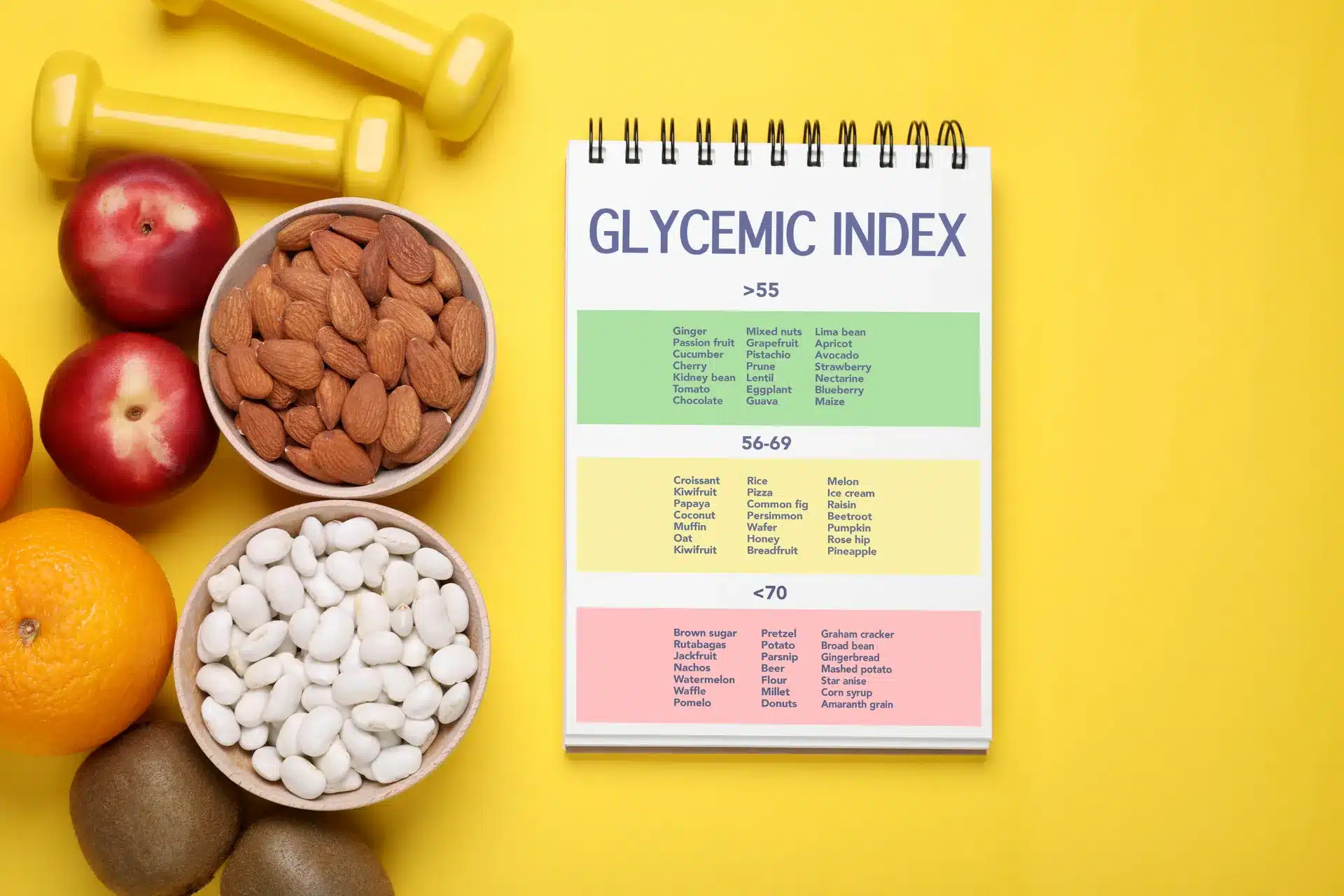Navigating the complexities of a diabetic diet can be a challenging task. Central to this challenge is understanding the glycemic index (GI), a crucial tool that can significantly aid in blood sugar management. The glycemic index provides valuable insights into how different foods affect blood sugar levels, enabling individuals with diabetes to make informed dietary choices. In this article, we delve into what the glycemic index is, how it works, and why it’s a vital component in the dietary management of diabetes. We will explore the differences between high and low GI foods, their impact on glucose levels, and how incorporating this knowledge into your diet can lead to better diabetes control. Whether you are newly diagnosed or have been managing diabetes for years, understanding the glycemic index can empower you to take greater control of your health through informed food choices.
What is the Glycemic Index?
The glycemic index is a rating system for foods containing carbohydrates. It shows how quickly each food affects your blood sugar (glucose) level when that food is eaten on its own.
- Measurement of Glycemic Index: Foods are ranked on a scale of 0 to 100. High glycemic index foods (70 and above) are quickly digested and cause a rapid increase in blood sugar levels. Low glycemic index foods (55 or less) digest slowly, causing a lower and slower rise in blood sugar.
- Glycemic Index vs. Glycemic Load: While the glycemic index measures the speed of glucose entering the bloodstream, glycemic load accounts for how much carbohydrate is in a serving of food and its glycemic index. It’s a more accurate way of assessing a food’s real-life impact on blood sugar.
- Factors Affecting Glycemic Index: The GI of a food can be influenced by its ripeness, how it’s cooked, and what it’s eaten with. Processing can also raise a food’s glycemic index.
- Importance in Diabetes Management: Understanding the glycemic index can help those with diabetes predict how their blood sugar will respond to different foods and guide them in making healthier food choices.
The glycemic index is a useful tool, but it’s not the only thing to consider when planning a diabetic diet. It should be used in conjunction with other nutritional information for a well-rounded approach to diabetes management.

High vs. Low Glycemic Foods
Understanding the difference between high and low glycemic foods is crucial for effectively managing diabetes through diet.
1. High Glycemic Foods: These foods, such as white bread, most white rices, corn flakes, and potatoes, have a GI score of 70 or above. They are quickly digested and absorbed, causing a rapid spike in blood sugar levels. For diabetics, frequent consumption of high GI foods can lead to difficulty in managing blood glucose levels.
2. Low Glycemic Foods: Low GI foods, like most fruits and vegetables, beans, minimally processed grains, pasta, low-fat dairy foods, and nuts, have a GI score of 55 or less. They are digested and absorbed more slowly, leading to a gradual rise in blood sugar levels. Incorporating these foods into your diet can help in maintaining steady blood glucose levels.
3. Moderate Glycemic Foods: Foods with a GI score between 56 and 69, such as basmati rice and whole wheat products, fall into this category. These foods have a moderate effect on blood sugar levels.
4. Balancing Your Diet: A diabetic diet doesn’t have to eliminate high glycemic foods entirely but should focus on balancing them with lower GI options. For example, pairing a high GI food with a low GI food can balance the overall glycemic impact of a meal.
5. Personalized Glycemic Response: It’s important to remember that individual responses to foods can vary. Monitoring blood sugar levels after eating different foods can help determine your body’s unique response to them.
Incorporating a variety of low and moderate glycemic foods can make managing diabetes more manageable and enjoyable.
Benefits of a Low Glycemic Diet for Diabetics
Adopting a low glycemic diet offers several advantages for individuals with diabetes, aiding in better blood sugar management and overall health.
Improved Blood Sugar Control: Low GI foods cause a slower, more gradual increase in blood sugar levels, which can help in maintaining better glycemic control, a critical aspect of diabetes management.
Reduced Insulin Spikes: By preventing rapid spikes in blood sugar, low glycemic foods can also help in reducing the need for excessive insulin, which is particularly beneficial for individuals with type 2 diabetes.
Increased Satiety: Foods with a low glycemic index often have higher fiber content, which can promote satiety and help in weight management. Maintaining a healthy weight is crucial for managing diabetes effectively.
Lower Risk of Complications: Consistently high blood sugar levels can lead to various complications. A low glycemic diet can help reduce this risk by maintaining more stable blood sugar levels over time.
Heart Health Benefits: Many low GI foods are heart-healthy. They can improve cholesterol levels and reduce the risk of heart disease, which people with diabetes are at an increased risk for.
Dietary Flexibility: A low glycemic diet doesn’t mean a restrictive diet. It offers a wide variety of food choices, allowing for flexibility and enjoyment in meal planning.
Incorporating low glycemic foods into a diabetic diet is not just about controlling blood sugar levels; it’s also about enhancing overall health and wellbeing.

How to Use the Glycemic Index
Utilizing the glycemic index in everyday life involves more than just understanding the concept; it’s about applying this knowledge to make smarter food choices.
Choosing Low GI Foods: Incorporate more low GI foods into your diet, such as whole grains, legumes, nuts, seeds, fruits, and non-starchy vegetables. These foods will help maintain stable blood sugar levels.
Combining Foods: Pair higher GI foods with lower GI foods to balance the overall glycemic impact of a meal. For example, if you eat a high GI food like white rice, combine it with vegetables and lean protein to slow down the absorption of glucose.
Cooking and Food Preparation: The way food is cooked can affect its GI. For instance, al dente pasta has a lower GI compared to overcooked pasta. Similarly, whole fruits have a lower GI than fruit juices.
Understanding Individual Responses: It’s important to note that individual responses to foods can vary. Monitoring your blood sugar levels after eating different foods can provide insights into how your body responds to them.
Creating a Balanced Diet: Remember, the glycemic index is just one tool in diabetes management. It should be used alongside other nutritional considerations to ensure a balanced and nutritious diet.
By integrating the glycemic index into your dietary choices, you can take an active role in managing your diabetes and improving your overall health.
Limitations of the Glycemic Index
While the glycemic index is a useful tool for managing diabetes, it’s important to be aware of its limitations and use it as part of a broader dietary strategy.
Not a Standalone Tool: The glycemic index doesn’t account for the amount of food eaten, which is also a crucial factor in how a food affects blood sugar. The glycemic load is a more comprehensive approach as it considers both the quality (GI) and quantity of carbohydrates.
Individual Variations: Different people may have different blood sugar responses to the same food. Factors such as individual metabolism, insulin resistance, and even the time of day can influence how your body reacts to certain foods.
Nutritional Completeness: Focusing solely on the glycemic index might lead to excluding certain foods that are high in nutrients but have a high GI, such as some fruits and vegetables.
Processing and Preparation: The GI of a food can change with the way it’s prepared and processed. For example, the GI of pasta can vary depending on how it’s cooked.
Overemphasis on Carbohydrates: While managing carbohydrate intake is crucial for diabetes control, it’s also important to consider other aspects of nutrition, such as protein, fat, vitamins, and minerals.
Using the glycemic index as one of several tools in your dietary arsenal can provide more flexibility and effectiveness in managing diabetes.
Glycemic Index and Overall Nutrition
While the glycemic index is an important tool for managing diabetes, it’s crucial to consider it within the broader context of overall nutrition.
Holistic Approach to Diet: A balanced diet for diabetes management should include a variety of nutrients. It’s important to look at the overall nutritional profile of foods, not just their glycemic index.
Inclusion of High Nutrient, High GI Foods: Some high GI foods, like certain fruits and root vegetables, are rich in vitamins, minerals, and fiber. Excluding these foods based solely on their GI can deprive your diet of essential nutrients.
Protein and Fat in Diet: Including healthy sources of protein and fat in your meals can help slow down the absorption of carbohydrates, reducing the likelihood of blood sugar spikes.
Understanding Food Combinations: Combining foods can affect the overall glycemic impact of a meal. For instance, eating a high GI food along with foods high in fiber, protein, or fat can balance the meal’s glycemic effect.
Monitoring and Adjusting: Regular monitoring of blood sugar levels can help you understand how different foods and combinations affect your body, allowing for more personalized dietary choices.
Consultation with Healthcare Providers: Working with a dietitian or diabetes educator can help you understand how to balance the glycemic index with other nutritional needs.
Incorporating the glycemic index into your dietary plan should be part of a comprehensive approach to nutrition, ensuring a well-rounded and healthful diet.
The Diabetes diet is a carefully crafted nutritional plan designed to help manage blood sugar levels effectively. By emphasizing complex carbohydrates, fiber-rich foods, and portion control, this diet empowers individuals with diabetes to maintain stable glucose levels and reduce the risk of complications. It's not just a dietary choice; it's a powerful tool for better health and improved quality of life.
Conclusion: Embracing the Glycemic Index in a Comprehensive Diabetic Diet
The glycemic index is a valuable tool in the dietary management of diabetes, offering a way to understand and predict how different foods can affect blood sugar levels. However, its true effectiveness lies in its integration into a broader, more comprehensive approach to nutrition. By considering the glycemic index alongside other factors such as overall nutrient content, portion sizes, and individual responses, individuals with diabetes can create a more balanced and effective dietary plan.
Embracing the glycemic index is not about restricting food choices; it’s about making informed decisions that contribute to better blood sugar control and overall health. Remember, every individual’s response to foods can vary, so personal experience and regular blood sugar monitoring are key in tailoring a diet that works best for you.
By using the glycemic index as one of many tools in your dietary arsenal, you can enjoy a diverse, nutritious, and satisfying diet that supports your diabetes management and enhances your overall quality of life.












